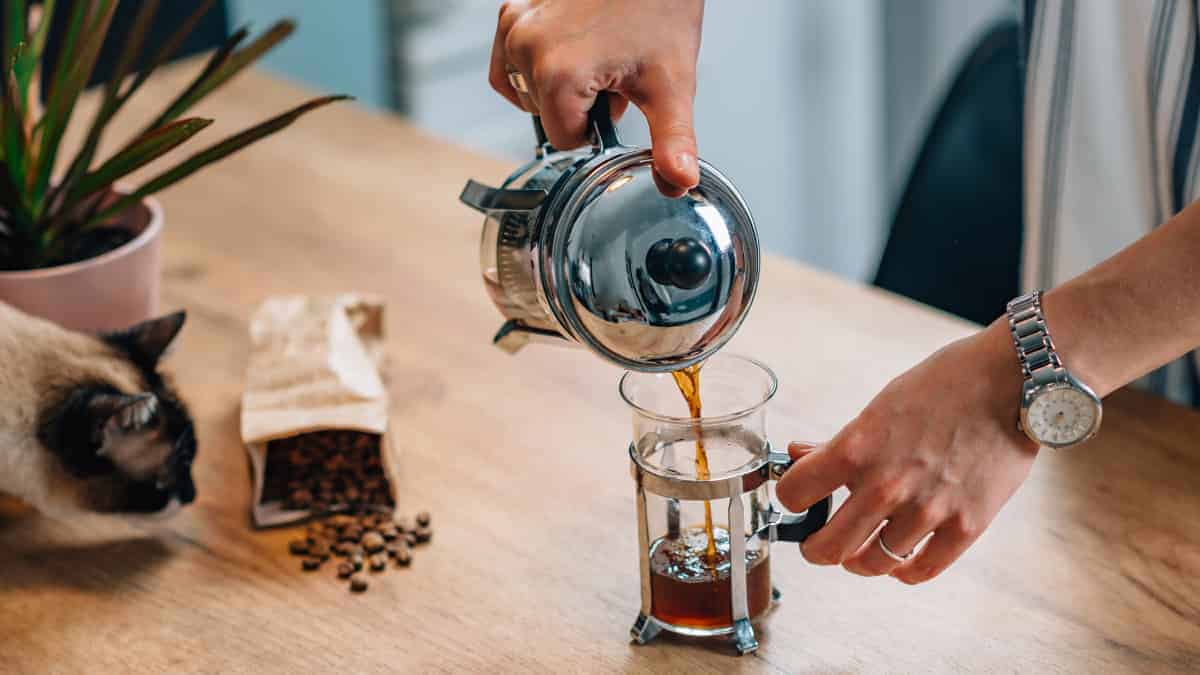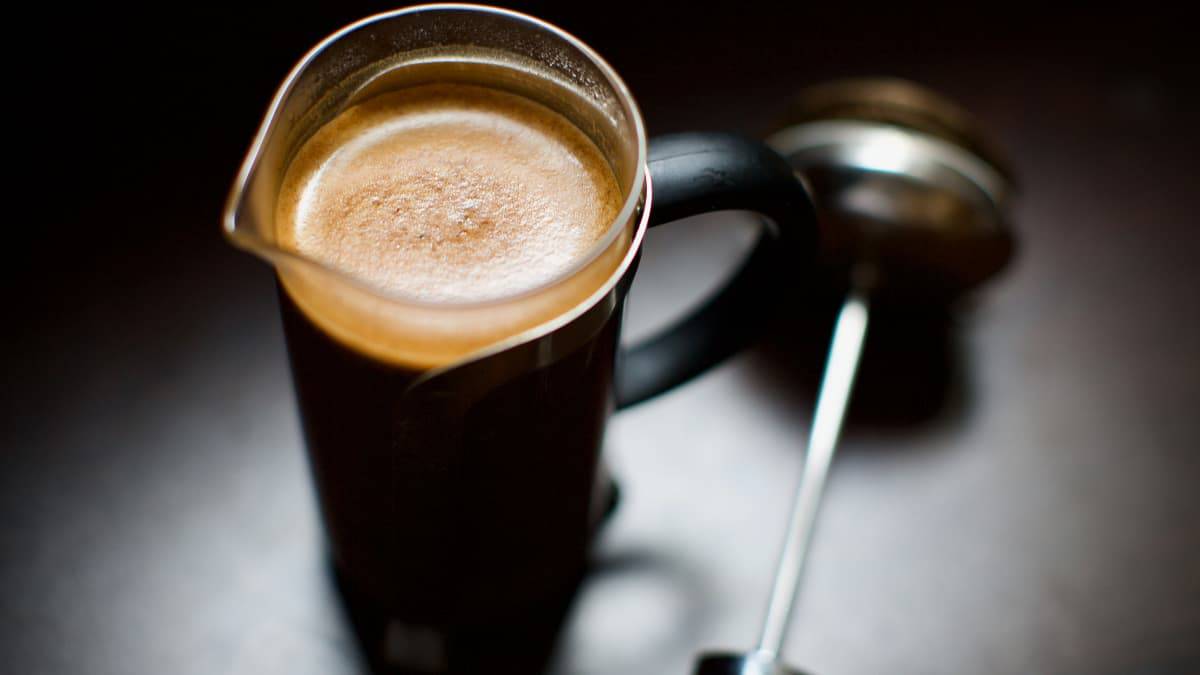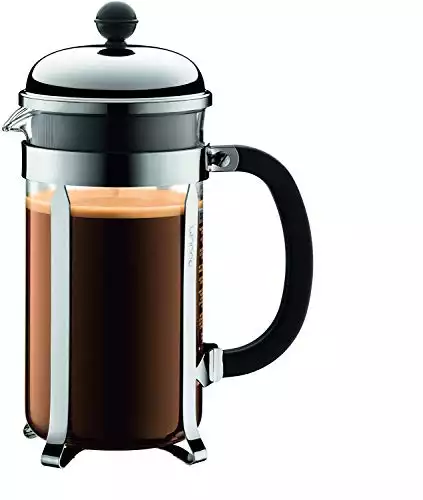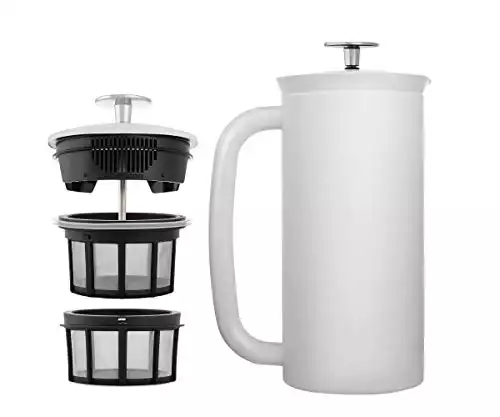How To Use A French Press For Tasty Coffee
The French press is a classic, and while it’s also one of the easiest methods of making delicious coffee, most people aren’t using it correctly.
Using a few simple principles, we can perfect the art of how to use a French press, making tasty brews on repeat.
So, if you’re stuck with a bitter or watery cuppa Joe, stay tuned to figure out how to make the best French Press coffee you’ve ever tasted!

Prerequisites: Buy The Right French Press
A French press is an incredibly simple device. It’s essentially a beaker (a glass pot), a plunger, and a filter. Though each part is very basic, each plays a vital role in brewing a delicious cup of coffee.
If we choose a sub-par French press— one with thin walls and inadequate filtration, we might not be able to extract everything we want to from the coffee.
Now, I’m going to put myself out there for educational purposes and embarrass myself with a short story.
I once bought a French press from a big supermarket in China for 10RMB (about $2). Don’t judge me! In my hurried packing, I forgot to bring my trusty Espropress. The $2 bright pink handled French press was all they had, so it had to do.
Anyway, the French press in question had an especially thin press pot. This meant that too much heat escaped during the brew. There was no insulation and the heat dissipated quickly, resulting in an under-extracted cup of French press coffee.
I could grind finer to make up for it, and I could wrap a sock or towel around it for extra insulation to keep the water hot, but it wasn’t ideal. Don’t get me wrong, it was an absolute steal for $2, and it did the job for the trip. But it wasn’t the best French press and isn’t something you’d want to use daily.
When choosing a French press, here are three essential things to consider.

Capacity
The first step is deciding the size you need. Simple enough!
Medium: 2-4 cups
If you only ever brew one cup at a time, a small to medium-sized French press is probably perfect for you. This size is also excellent to travel with— a nice size for both inner-city and backcountry camping adventures.
Large: 8-12 cups
For the coffee fanatic who drinks loads of coffee, and the romantic who makes morning coffee for their lover, a large French press is probably more your speed.
These aren’t so good for traveling because a good one will be quite heavy. They are good, however, for making lots of coffee!
A large French press is more of an all-rounder French press. So if you’re looking at only buying one, and you’re not sure about sizing, go for the large. It’ll give you more options.
Filtration
There are a couple of different filtration styles available in the French press. The job of a French press filter is to separate the brewed coffee from the grounds.
The more traditional style consists of a plunger with a knob on one end and a disc-style mesh filter on the other. The mesh wraps around a disc-shaped frame which then screws onto the plunger shaft. This type of filter will separate the coffee grounds from the brewed coffee once the infusion is complete, allowing through only the smallest particles and the oils into the cup of coffee.
The downsides of this filtration style are that the mesh can eventually bend out of shape, and you will end up with some fine particles or ‘sludge’ in the bottom of your cup. Not super nice if you accidentally drink it to the last drop!
Far less common than the disc-style filtration system, we have basket style filtration.
This is the style of filtration used for the Espropress P-series French press, and it provides a super clean, sludge-free cup of French press coffee. The secret here is in the double cup mesh filters.
We still have a plunger with a knob on one end, but on the other, we find two mesh ‘filter cups’. These cups fit together to form one super solid filter that not much can get past. Wrapped around the filter cups there is a rubber seal, stopping any coffee from escaping the clutches of the filter.
You can add paper filters in the gap between the cups, producing a glorious pour-over/French press mutation.
The downside to this type of filtration is that it’s pretty expensive when compared to a standard French press.
Style
Style is all about the build of the press pot beaker. Steel, glass, single wall, or double wall? This is probably the most important part of the French press.
Double Walled or Single Walled?
Choosing between a double or single-walled beaker is all about insulation. The more insulation a French press beaker has the more heat that will be retained within the brew. And the more heat retained within the brew, the more efficiently our coffee grounds can be extracted.
A double-walled French press is essentially two beakers— an inner one and an outer one, usually with a layer of air between the two. This allows the inside of the French press to get hot and retain that heat.
That’s not to say that all single-walled French presses are bad, and all double-walled ones are good. The classic Bodum Chambord French press has a single-walled beaker and still brews an exceptional cup of French press coffee.
If you’re still tossing up between a double or single-walled beaker, check out our French press guide for all the stats and deets of the best French presses available in 2021.
How To Use A French Press Coffee Maker
Immersion Brewing
The French press is a style of immersion coffee brewing. Here, all of the ground coffee and all of the hot water are in contact for the entirety of the brew. At the end of our prescribed brew time, around 4 minutes, the liquid coffee and the coffee grounds will be separated by a filter.
This will leave us with a coffee that is much fuller and heavier than pour over coffee using paper filters.
Controlling the balance
Learning how to control the extraction rate of the coffee is an important step in the process of learning to brew.
If we can control the extraction rate accurately, we can control the balance of the coffee. We can make it sweeter if we want to, or we can reduce the bitterness caused by over extraction if need be.
As your coffee brews, it is dissolving a portion of the mass of the coffee using hot water. This portion is somewhere in the league of 20 percent.
As a brew progresses, we find that certain flavors come out at certain times. First, we usually extract the coffee’s acidity. Acidity is usually followed by sweetness, which is then followed by bitterness.
The optimal point for any coffee is just before sweetness becomes bitterness. Bitterness is usually associated with over extraction, and sourness— under extraction.
We can control this balance using two variables— coffee grind size and brew time.
If we grind our coffee beans fine, we don’t need to brew for too long to gain a decent extraction. If we grind coarse, we will need to brew for longer, and with higher temperature water to achieve the same level of extraction.
So if we set our brew time at 4 minutes, things become super simple.
If your brew tastes sour and lacks sweetness, grind finer. If it tastes bitter and feels dry in the mouth, grind coarser.
Finding this balance is the easiest way of making sure your coffee is at its best.
We can use this same principle for pretty much any brew method.

What You’ll Need
French Press
If you can, go for a double walled French press as these retain the heat better. For this brew recipe, we’re going to use a fairly large French press. If you are using a smaller french press, just follow the same 1:15 ratio to get the same result.
Burr Coffee Grinder
The most important part of any coffee brewing setup is the coffee grinder. The job of a coffee grinder is to cut the coffee beans evenly so that each particle is approximately the same size. Uniform, even grinding is what will give us those well-defined flavor notes in the cup.
The grinder must use burrs, rather than blades. Using a burr grinder, we can control the grind size accurately, allowing us to dial in each coffee. While not perfect, a blade grinder is still better than using pre ground coffee (which should be avoided like the plague!).
Some burr grinders are more geared toward French press brewing than others, so be sure that you pick one that can hit the sizes you need.
Coffee
For this recipe, we’re going to use 40 grams of coffee. The amount of coffee grounds we use is relative to the amount of water. Using 40 grams of coffee and 600ml of water is a 1:15 coffee to water ratio. You can, by all means, use a smaller amount of coffee grounds.
Use the best coffee your can afford. Light to medium roasts work well. If you are using a dark roast, be prepared for the coffee to degas like crazy when you pour the water over it. See, this degassing is actually demons trying to escape the poor too-dark roasted beans— so be careful!
Try to avoid pre ground coffee. Pre ground coffee goes stale quickly, usually within a few days of grinding.
Fresh water
Try to make French press coffee using water that is Ph neutral, with a TDS of 150 milligrams per liter of water. Your water should be fresh and clean with no color or odor. If you live in an area where the water isn’t ideal, think about picking up a water purifier or using large refillable jugs of filtered water.
We’re aiming for a water temperature of about 95 degrees celsius.
Scales
When it comes to scales, the more sensitive the better. Ideally, a good coffee scale should measure in 0.1g increments.
You can also use tablespoons or a measuring cup to measure the amount of coffee you are using. You’ll need around 8 tablespoons of coffee to reach 40 grams. You can also use a measuring cup to measure out the water you are using.
Timer
Use a timer, like the one built into your phone to keep track of the brew time.
Stirrer
To ensure all the coffee is well extracted, we need some sort of stirring device. This could be a paddle, a stirring stick, or a spoon.
Brewing French Press Coffee
Let’s get to it and learn how to make French press coffee!
We are going to use a 1:15 coffee to water ratio. If you like your coffee more delicate, go for a higher coffee to water ratio, maybe something closer to 1:17.
You’ll Need:
- French press
- Burr Grinder
- Kettle
- 40g Coffee beans
- 800ml Water
- Timer
- Stirrer
- Scales (optional)
Step 1
First, put your 800ml of water on to boil. When the water is hot, pour about 200ml of hot water into the French press beaker.
This will both preheat and rinse it. Preheating all brewing gear with hot water is an important step. This will stop the beaker of the French press from sapping away the heat from the actual brew water, keeping our brew nice and toasty.
Step 2
Traditionally, French press coffee uses a coarse grind. But many coffee lovers have realized this rule doesn’t make a whole lot of sense. When we cup coffees, we use fairly fine grounds— and it tastes pretty damn good!
So that’s what we’re going to do. Don’t worry too much about over extraction— just try to find that spot where the sweetness is.
Weigh out 40 grams of coffee on your scale and grind it at a medium-fine setting, similar to white sugar. As I mentioned earlier, we can play with the size of the grounds. Start with something in the medium-fine range and adjust as necessary.
Step 3
Discard the rinse water from the French press beaker and add the coffee. Place the French press on the scale and press tare. Have your timer ready to go. Ensure your water is still hot, with a water temperature of around 95 degrees celsius.
Step 4
Press start on the timer and pour 600ml of hot water aggressively over the coffee. We want to make sure every little bit of coffee is wet. Remove the beaker from the scales and give the coffee a few good stirs. Place on the plunger, but don’t yet press it— just use it as a lid while the coffee brews.
We are going to leave the French press and let the coffee brew for 4 minutes.
Step 5
Once the time is up, take your spoon and stir the coffee. Don’t just stir the crust at the top— be sure that you stir down at the bottom, too. Stir the coffee about 8 times. You don’t have to be too crazy about only stirring 8 times, just be sure that everything is mixed without going overboard.
Step 6
Place on the plunger and wait one minute before you press the plunger. This step isn’t 100% necessary, but I find letting the finer coffee grounds fall to the bottom allows the plunger to go down much easier.
Step 7
Gently press the plunger all the way to the bottom. Pour into your cup or a carafe, discard the used coffee grounds, and enjoy your French press coffee!
Frequently Asked Questions
How much coffee for a French press?
Go with a coffee to water ratio of between 1:15 and 1:17. This will mean 1 part ground coffee to 15 – 17 parts water.
If you are using 600ml of water, use between 35 and 40 grams of ground coffee. If you like your coffee stronger, use a lower coffee to water ratio. If you like your coffee a little more subtle, use a higher ratio.
How does a French press work?
The French press coffee maker is an immersion brew method.
Immersion coffee brewing is when all the hot water and all the coffee are together for the entirety of the brew. This is different from drip coffee brewing methods that introduce hot water to the coffee incrementally.
After a set amount of time, the brewed coffee liquid is separated from the coffee grounds with the use of the plunger. The filter of a French press is attached to the end of the plunger.
When the plunger is inserted into the French press beaker and pressed down, it pushes the ground coffee to the bottom of the beaker. The coffee can now be poured from the beaker, while the coffee grounds remain.
Is French press coffee better?
While it’s hard to say if French press coffee is the best, it is the most honest representation of a coffee. It doesn’t use different pouring patterns to bring out the acidity or sweetness of a coffee— what you get is what you get.
Coffee producers and roasters use a similar form of immersion coffee brewing known as cupping. They use this technique to evaluate the quality of any coffee.
Cupping brews coffee in basically the same way a French press does, except cupping doesn’t use filtration. Basically, you pour hot water over coffee grounds and let them steep, before tasting the coffee, usually using a cupping spoon.
Immersion brewing methods like these are great because if the coffee doesn’t taste great, you can pretty much rule out the brew method as the issue.



